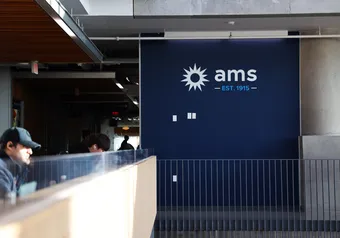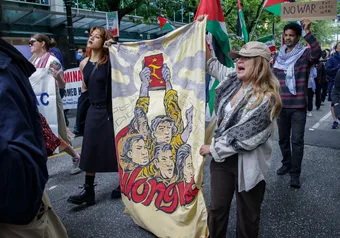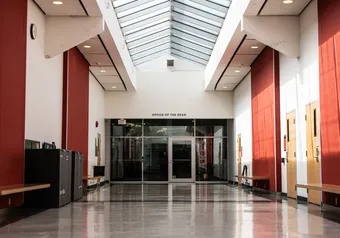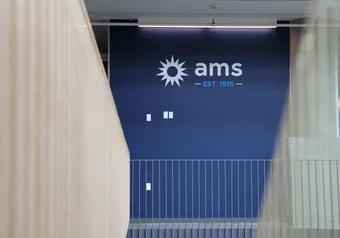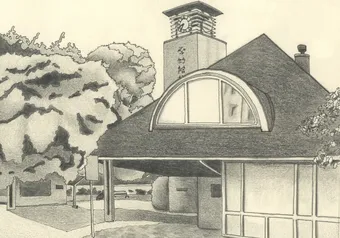There are three referendums being put forward on this year’s AMS elections ballot. One of them, if successful, will establish a fee that would fund the construction of a student fitness and recreation building on campus. Another would allow the AMS to sell up to four pieces of art from their collection. The final one consists of changes to the AMS’s bylaws that reflect recent changes to the governance structure and are intended to reduce redundancy.
How exactly do referendums work?
A referendum is called for two reasons — either AMS Council has passed a resolution to hold one, or a petition has been signed by at least 1,000 students. This year, the only referendums on the ballot were put forward by AMS Council. Referendums can only be phrased in a “yes or no” format for students to answer when voting.
A referendum doesn’t necessarily have to be held at the same time as elections, but timing them to occur simultaneously makes it more likely that the vote will achieve the eight per cent of eligible voters required to meet quorum — the minimum number of “yes” votes it must have to pass.
The eight per cent quorum may seem low, but given the usually low voter turnout, it can be harder than it sounds. In order for a referendum to pass, the winning side also needs more than 50 per cent of the votes, or if the referendum concerns AMS bylaws or constitution, 75 per cent.
This means that for this year’s referendum on bylaws to pass, there isn’t much room for voting students to answer “no.” So, if you’re voting, make an informed decision — you might be the deciding vote.
The athletics referendum
The question: “Do you support the AMS establishing a graduated fee (‘The Fee’) to contribute to the construction of a student fitness and recreation building at UBC Vancouver?”
If passed, this fee will begin at a sum of $5 for each student, and then increase an additional $5 per year until it reaches a $25 annual amount per student. The fee would go towards the construction of a building to be funded half by students (through this fee) and half by the university in conjunction with UBC’s GamePlan. The fee would exist until the student half is completely paid for, to a maximum of $22.5 million towards project costs (the project is estimated to cost $45 million).
What would the new building look like? Preliminary plans show a combination of fitness space, gymnasium and support space.
“The fees that students are already paying [$21] are going towards programming, and that’s all of the classes and the games that are available to you right now,” said Ava Nasiri, AMS president, in a previous interview with The Ubyssey. “What this new fee would be [for] is an actual building.”
Keegan Zanatta, an executive in charge of events for the Thunderbird Athletes Council (TAC), took charge of helping the AMS with this campaign backed by unanimous support from the TAC.
“I decided to run point of this [for the TAC] to try and give back to campus a little bit and improve the student experience,” said Zanatta.
This referendum aims to remedy the fact that UBC, as one of the top universities in Canada, has a “pitiful” amount of fitness space, as described by Zanatta.
As shown in the chart below, UBC, with its large population and finite fitness space, has a very small ratio of fitness space square-footage per student compared to other schools.
“The biggest thing is just that this is a student-run initiative for other students to try and improve their experience on campus. This is by the students, for the students. It’s a fee, yes, but it’s a for-our-own-good type of thing,” said Zanatta.
His only wariness of the referendum comes from the fact that there might not be a big enough voter turnout to pass it — in which case, according to him, it’s back to the drawing board for next year.
For more information, we’ve covered this referendum in a previous article. As noted by Nasiri, if approved, this fee would show the Board of Governors that students are serious about more fitness and athletic space on campus — but it does come at a cost.
The sale of AMS art pieces
The question: “Do you authorize the AMS to sell up to four pieces of art from the AMS Permanent Collection?”
The AMS has a 72-piece art collection currently valued at $4.5 million.
“We have four or five pieces that make up half of the worth of the gallery,” said AMS VP Administration, Chris Scott. “We would be looking probably for those more expensive ones to go because those are the ones that probably would be required to gain enough interest for the endowment.”
The most expensive piece is E.J. Hughes’ “Abandoned Village, River’s Inlet,” which is valued at $900,000.
A similar referendum question allowing the AMS to sell three pieces of art was already passed in 2012 — however, that question placed a one-year time limit on the sale. This lack of flexibility was problematic, and could have led to a potential income loss if they sold a piece when the time wasn’t right.
The flexibility also allows the AMS to adjust which painting they would sell based on rental income incurred by particular pieces.
“If suddenly in two years the one that’s worth $900,000 is getting rented out all the time, then we probably wouldn’t sell that one,” said Scott.
Selling the four most expensive pieces would also save the AMS $15,000 in insurance payments every year.
“Essentially, that's what we’re looking to do ... stay within the mandate it was donated to us for and make it more relevant to students,” said Scott.
AMS bylaw changes
The question: “Do you support and approve amending the AMS Bylaws in accordance with the changes presented in the document entitled Bylaws Amendment Package 2017?”
The AMS has both bylaw and code governing it as a society. While AMS Code can be changed within Council when needed, bylaws are the most binding constitutional document that the AMS takes direction from. To change them, there needs to be either a referendum vote or an annual general meeting that reaches quorum.
“Most years, the AMS has some housekeeping bylaw changes, but this year we have some that are really, really important,” said AMS President Ava Nasiri.
According to Nasiri, the changes are intended to streamline and clarify parts of bylaws to make for smoother governance in the years to come.
Note that all of the following, more specific questions are packaged under the bylaw change referendum like an omnibus bill — a vote is a vote for all to pass.
“It would not make sense to split them because they are all based off of recommendations from the governance review,” said Nasiri, referring to the external review process conducted on the AMS by consulting firm MNP earlier this year. AMS Council accepted all of those recommendations on the principle that picking and choosing would have made the review moot.
On changes from the governance review: “Do you support and approve amending the AMS Bylaws in accordance with the changes presented in the document entitled Bylaw Amendments: Structure of Council?”
These proposed amendments would change the section titled “members” so that Senate and Board of Governor student representatives would no longer officially sit on Council. They will still have seats and even make presentations, but would not be able to officially vote should this referendum pass.
Additionally, changes are being made to the threshold of how many students in a faculty equate to a single Council seat — from 1,500 to 3,000 students. This is being done because increased enrolment numbers of the university are resulting in too many seats on Council, according to the governance review.
In Nasiri’s opinion, this won’t affect the quality of representation that larger faculties get.
“You maintain the proportionality of the representation because inherently, no matter what, you do arts and the GSS are always going to have more seats,” said Nasiri.
Finally, with a change to Bylaw 13, “new student associations for degree-granting schools shall only be recognized as constituencies if their enrolment exceeds one per cent of the total enrolment of UBC Vancouver.” Bylaw 22, on the incorporation of branch societies, is being removed entirely.
On changes from the governance review: “Do you support and approve amending the AMS Bylaws in accordance with the changes presented in the document entitled Bylaw Amendments: General Manager/Managing Director?”
“After the formal restructuring of our senior manager organizational chart, the new title that better reflects the responsibility of our managing director should be in the bylaws as the best practice moving forward,” said Nasiri.
She cites the efforts to increase cohesiveness between the business and governance sides of the AMS as a good reason why the role of managing director is gaining more breadth — hence the name change to match the changing responsibilities.
On changes to the Student Administrative Commission (SAC): “Do you support and approve amending the AMS Bylaws in accordance with the changes presented in the document entitled Bylaw Amendments: Bylaw Changes SAC & Budget Committee?”
SAC is a “relic from 1960s AMS,” according to Scott, who was also SAC’s vice-chair last year. When it was created, the SAC acted as the executive committee, but within four years of its establishment, it was stripped of its power due to its inefficiency.
“We’ve been trying to make it fit with the modern AMS when in reality, it doesn’t have a place,” said Scott.
If this referendum passes, it will remove all mentions of SAC from AMS bylaws. Its role in club policy and legislation will be taken over by the operations committee, and implemented by the VP Administration and their staff. The VP Administration will take over the SAC’s role in cases where approval is needed for functions or charity drives.
“I’m looking forward to the increased efficiency that you will see. There will no longer be that bureaucratic loop to jump through to get stuff done,” said Scott.
On the investment policy: “Do you support and approve amending the AMS Bylaws in accordance with the changes presented in the document entitled Bylaw Amendments: Bylaw Changes Investment Policy?”
The investment policy question may seem a little jargon-y or confusing given that it regards how the AMS plans to change the way that it invests their sizeable reserve fund of $16.8 million.
We wrote a more detailed article on the proposed investment policy, but essentially if passed, this would change the current policy of 100 per cent fixed income (very safe) investment to a policy of 70 per cent fixed income and 30 per cent equities. That 30 per cent equity investment comes at a higher risk financially, but could result in an extra $500,000 in annual returns for the AMS to spend, according to VP Finance Louis Retief.
“[What this change is] is how grandmas invest,” said Retief in an interview with The Ubyssey. “The chances of losing money are slim.”
In short — higher risk, higher (potential) reward.
First online
Share this article


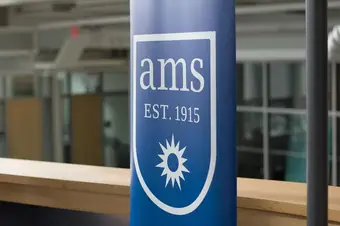
![['']](https://storage.googleapis.com/ubyssey/media/renditions/Screen_Shot_2017-03-06_at_7.10.4.width-1000.format-webp.webp)
